 Montreal
born artist Kapil Harnal (1977-) obtained his BA in Fine Arts
from Concordia University, has exhibited in Montreal at The Lawless
Gallery (1999), Galerie Schorer (1999-2001), The VA Gallery at
Concordia University (2001), La Galerie 1637 (2001). His first
solo exhibition was at Galerie Entre-Cadre (2002).
Montreal
born artist Kapil Harnal (1977-) obtained his BA in Fine Arts
from Concordia University, has exhibited in Montreal at The Lawless
Gallery (1999), Galerie Schorer (1999-2001), The VA Gallery at
Concordia University (2001), La Galerie 1637 (2001). His first
solo exhibition was at Galerie Entre-Cadre (2002).
____________________________________
The art of Kapil
Harnal is an interesting addition to the contemporary Canadian
art context. His work evokes the baroque and classical styles
through a realist approach to drawing, colour and use of light.
He employs unique forms of representation that imbue his paintings
with modernity and freshness. And while he portrays people, he
does not make portraits. As he explains, “The individual
comes into the concept rather than the concept being about the
individual.” Harnal creates paintings that reconfigure the
traditional notion of portraiture by juxtaposing his refined technique
with unique and often humorous concepts. Through this sometimes
light and comical approach, Harnal serves notice that he does
not want to load his paintings with complex ideas. However, some
of Harnal’s paintings do in fact carry a strong message
and could be interpreted through a wide range of associations:
in some instances, the messages can be quite controversial. That
he does not view himself as a symbolist or conceptual painter
is beside the point seeing that once a work of art is out of the
hands of an artist it can be construed in an infinite number of
ways.
Harnal
is undoubtedly a talented and skilled artist who has a strong
command over colour and light. Some of his earlier works demonstrate
the eagerness and curiosity of a young painter experimenting with
different media and forms of representation. At one point, he
was interested in reproducing frozen frames from films such as
Francis Ford Coppola’s Rumblefish. To these images,
he added his own light and colour schemes in order to achieve
the desired effect. At around the same time, he became intrigued
by surrealist concepts, such as found objects, applied to The
Sleeper, which features a sleeping nude woman framed by the
head board of a bed to the effect that the image of a sleeping
figure is so closely tied to the idea of a bed it pre-empts the
free association characteristic of surrealism. “Duchamp
would have been rolling over in his grave over that one,”
joked Harnal.
The Sleeper
oil on wood, 34 x 18 in.
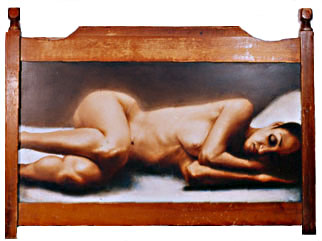 |
His most
recent work features the presence of the female figure, usually
portrayed nude or scantily dressed. This contrasts with his earlier,
classical representation of women that allowed Harnal to hone
his talent as a figurative painter. But it was only after his
peers criticized him for not pushing the envelope enough that
he began to experiment with new forms.
His current
Face Card Series reveals Harnal’s predisposition
to classical representation, yet what is new here is the painter’s
own modern and imaginative twist.
The
Face Card Series is a technically striking collection of paintings
that depicts human figures in the form of playing cards. The idea
a card could be likened to a canvas came to him in 1996 while
painting a traditional card for an art class.
In the
Queens of Hearts and Clubs, as in all other 'cards', the dual-figured
representations are not mirror images of each other, so the viewer,
to his/her pleasant surprise, uncovers movement and vital presence
in what would otherwise be a motionless and flat form of representation.
If only Harnal had pushed creative envelope even further by exploring
the symbolic and dualistic possibilities that are already implicit
in the work; instead, he sticks to his stated artistic intent:
to produce work that is light and disarming.
Queen of Hearts
oil on panel, 48 x 32 in.
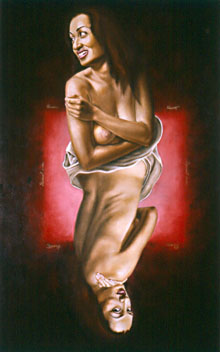 |
|
Queen of Clubs
oil on panel, 48 x 32 in.
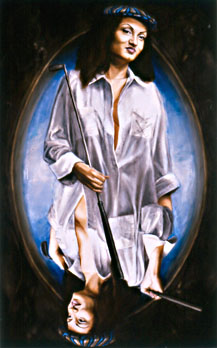 |
|
Queen of Apples and Peaches
oil on panel, 48 x 32 in.
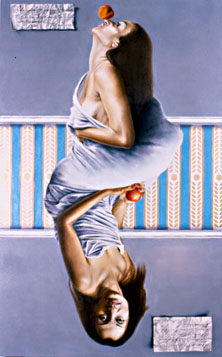 |
|
Queen of Diamonds
oil on panel, 48 x 32 in.
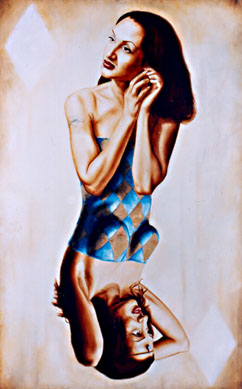 |
|
Queen of Potatoes
oil on panel, 48 x 32 in.
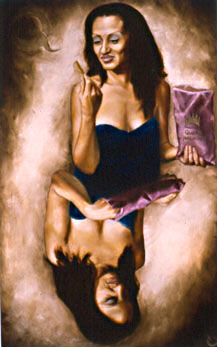 |
If historically
cards have been used to reveal hidden meanings, in Harnal’s
series several of the pieces can be viewed at ‘face’
value. His approach is often refreshingly tongue and cheek. In
The Queen of Potato Chips, he has added his own comical
suit and in The Queen of Clubs, he indulges in a clever
play on words by painting his model dressed in a golfing shirt
and cap coupled with a golf club in hand. Other works in the series
are more serious and emotive. The expression of the woman depicted
in The Queen of Hearts suggests a lover caught off guard:
here, the work’s intimacy is achieved through the Queen’s
playful expression. However, in the Queen of Spades, a
sinister quality pervades as the bare breasted woman looks connivingly
at the viewer while fingering the blade of a spade.
Some
of Harnal’s general depictions of women follow the historical
view that designates the female as the embodiment of evil and
sin. His partially or completely nude women can be read as having
exhibitionist tendencies while the only male in the series, (The
King), is a double portrait of Harnal himself, is fully and ornately
clothed. Whether or not this double standard is intentional, the
artist bares some responsibility for the effects. To wit: the
gratuitous nudity that appears throughout the series distracts
the viewer from penetrating the deeper meanings in, for example,
The Queen of Spades which has a powerful content. So again
with all due respect to the artist’s intended unserious
subject matter, his images evoke other evident associations.
Queen of Spades
oil on panel, 48 x 32 in.
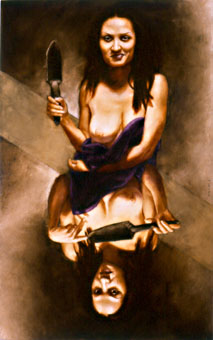 |
Harnal
is currently working on a series of corset images where once again
he runs the risk of authoring perhaps unintended but very problematic
associations. In Corset I, Harnal portrays himself tying
up the laces of the corset on the woman in front of him. He depicts
his body with strong movement, whereas the woman holds onto the
bed frame with a compliant expression on her face. Corsets have
been long recognized within feminist discourse as a symbol of
female oppression. The movement and expressions of the figures
in this painting could indeed reinforce these associations.
Corset I
oil on linen, 72 x 48 in.
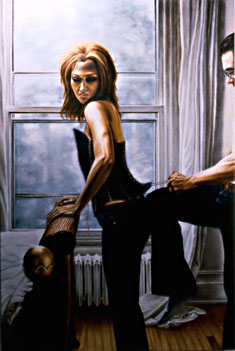 |
Harnal
is still a young man whose evolution as an artist is a work in
progress. He should be made aware of the danger that if he continues
to portray the female as an object instead of an object of contemplation,
his work may become stereotyped as exploitive, which would be
a shame because in much of it his voice is strong. When Harnal
takes full charge of that voice, the clarity that is now only
haphazard in his painting will be the foundation upon which his
reputation as a significant artist is established.